Buddha’s Gems: Chakin and Chanoyu
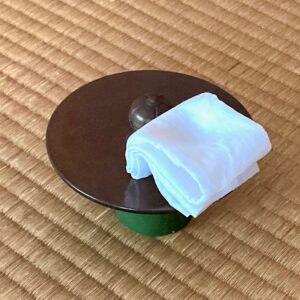
Every utensil is necessary in Chanoyu Tea presentations. From treasured bowls and tea containers to things that should be new, such as the cha-kin, 茶巾, tea-cloth, to wipe the cha-wan, 茶碗, tea-bowl, and the cha-sen, 茶筅, tea-whisk, to whisk the tea. If an object serves no purpose, it is not part of a true Tea.
Many aspects of Chanoyu are influenced by Buddhism: Cha Zen ichi mi, 茶禅一味, Tea Zen one taste, is a well-known example. The conical cha-wan, 茶碗, tea-bowl may be based on the seed pod of the lotus, which is sacred to Buddhism. Perhaps there are utensils that may have been inspired by other aspects of Buddhism, and possibly the Buddha himself.
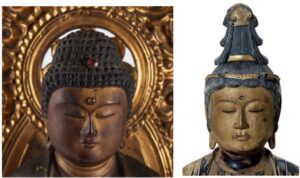
The two gems on the head of Amida are symbolic of enlightenment and wisdom. The gem slightly above the eyebrows is called urna from the Sanskrit, which in Japanese is byaku-go, 白毫, white-hair. This gem is most often made of clear, colorless crystal quartz. The gem stone on Amida’s head is called in Hindi ushnisha, crown, in Japanese is ni-kkei-shu, 肉髻珠, flesh-hair-jewel, is usually red. Nikkei is the mound of hair on the crown of Amida’s head.
The gem on the brow of Kannon is the byakugo, and is clear crystal. Kannon like other Buddhist deities does not have the nikkeishu, as it is the priority of the Buddha.
Buddha was a man, a prince, a beggar, an ascetic, a teacher, a fine example of a great man. He was an historical individual, and to this moment is ‘everyman’. Bodhisattvas, in Japanese, Bo-satsu, 菩薩, Grass-buddha, who are Buddhas in training, have hair. Bodhisattvas have beautiful hair filled with ornaments. Monks shave their heads for various reasons, vanity for one. Enlightenment does not require anything special for appearance. Hair is an impediment to self-realization – it requires attention. There is no time for such self-aggrandizement nor vanity. The Buddha is like any human being who continues to go about one’s life.
The Go-dai Nyo-rai, 五大如来, Five-great Like-becomes, the Five Buddhas are Dai-nichi Nyo-rai, 大日如来, Great-sun, A-shu-ku Nyorai, 阿閦如来, Flatter-crowd, Hō-shō Nyorai, 宝生如来, Treasure-life, A-mi-da Nyorai, 阿弥陀如来, Praise-increase-steep, and Fukūjōju Nyorai, 不空成就如来, No-void-become-settled. They are depicted with distinctive hair styles that may have symbolic significance. Buddha has short curls all over his head, and a bump or hemispherical mound on the top called in Sanskrit ushnisha, in Japanese, ni-kkei, 肉髻, flesh-topknot; the Kanji 髻 is also commonly read motodori, and mizura. Where the mound meets his head hair there is an adornment of a jewel called a ni-kkei-shu, 肉髻珠, flesh-topknot-jewel. It is unique to the Buddhas.
The ‘dot’ on his forehead called urna, that in Japanese is called byaku-go,白毫, white-hair. It is present on a myriad of enlightened beings. The light radiating from the urna is created by the action of the ushnisha which is identified with the chaki that is symbolic of lightning. The chashaku may be seen as a metaphor of the lightning bolt, ko-gō-sho, 金剛杵, gold-strength-pestle, of Indra/Taishakuten.
The importance of the light radiating from the urna is replicated by millions of followers with a decorative spot called a bindi, this adornment is also worn by Hindis, Jains, and Sikhs. Wearing a bindi symbolizes the practitioners’ devotion to achieving realization via the flow of the amrit, ‘elixir of life’, in Japanese kan-ro,甘露,sweet-dew.

There may be parallels between the cha-ki, 茶器, tea-container, and the red jewel on the crown of the Buddha, and the cha-kin, 茶巾, tea-cloth, and the crystal gem on the forehead of the Buddha. According to the Eki-kyō, 易経, Change-sutra, the tea container is displayed on a tray marked with the ha-kke, 八卦, eight-signs, placed on the trigram, ☳, for Shin, 震, Tremble, which is symbolic of inabikari, 稲光, lightning, and the beginning. The Kanji, 震, is composed of ‘rain’ and zodiac ‘Dragon’.
Rikyū adapted an incense burner stand for displaying Tea utensils, which became a maru-joku, 丸卓, round-stand. It should be remembered that Rikyū’s personal name was Sō-eki, 宗易, Sect-change, which indicates that he was deeply associated with the Ekikyō. The pictured stand is made of poplar wood, by Joseph Van Benten, Chestnut Hill, Mass. In the photograph above, displayed on the lower shelf, ji-ita, 地板, earth-board, is a mizu–sashi, 水指, water-indicate, Chinese porcelain brush rinser with blue some-tsuke, 染付, dye-attach, design of two dragons in clouds and inscribed plaque. Displayed on the upper shelf, ten-ita, 天板, heaven-board is a spherical, shu-nuri, 朱塗, vermilion-lacquered, wood cha-ki, 茶器, tea-container, ‘Hi no Maru’, 日の丸, Sun’s Round. The chaki can be one of a countless number of tea containers of various forms and styles in Japan, and elsewhere.
Also pictured above is the head of A-mi-da Nyo-rai, 阿弥陀如来, Praise-increase-steep Like-become, 13th century, Kama-kura Ji-dai, 鎌倉時代, Sickle-storehouse Time-generation, H. 51.5cm, Kanagawa Prefectural Museum of Cultural History.
Amida is one of the five great Indian Tathagata, in Japanese, Nyo-rai, 如来, Like-become, and is identified as a Buddha. The five Buddhas’ appearances are very similar. The Buddha’s hair curls are called ra-hotsu, 螺髪, snail(coil)-hair, after the form, not the creature. The fleshy mound-like protuberance on the top of Buddha’s head is called, in Sanskrit, uṣṇīṣa, Romanized to ushnisha, in Japanese is ni-kkei, 肉髻, flesh-topknot. The mound symbolizes the attainment of spiritual enlightenment. Ushnisha refers to a turban, diadem, and crown wound around the head. The word ushnisha comes from the root word usni meaning ‘burning’.
In the development of the iconography of the Buddha, the ‘mound’ according to ancient text was a swelling of his flesh, and later was depicted as a dome, a bun of his long hair tied into topknot. This form of this topknot became more like a lump on his head. What was once a bun of hair became a mound of flesh in the establishment of the 32 physical attributes of a great man, a Buddha. Elevated hair topknots are seen atop the heads of many enlightened deities. In some Buddhist imagery, a flame-like structure, honō no katachi, 炎の形, on the nikkei protuberance on top of the head represents satori, 悟り, understanding, the fundamental dependent sign of enlightenment. In front of the mound, is a gemstone that symbolically represents the Buddha’s wisdom and is called ushnisha, in Japanese, ni-kkei-shu, 肉髻珠, flesh-topknot-jewel.
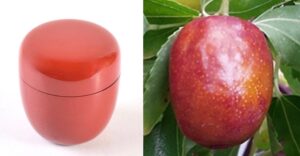
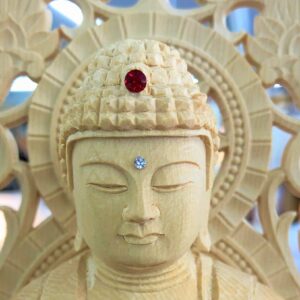
On the Buddha’s forehead slightly above his eyebrows is a feature called an urna, which is the Buddha’s ‘Great Mark of Honesty’, and is symbolic of divine vision, elevated consciousness, and spiritual enlightenment and is said to emit rays of light. The urna is a curled, long white hair called a byaku-go, 白毫, white-hair, although the hair of the urna is very rarely depicted. In its way, its perceived absence enhances its secret importance, and it is usually represented by a crystal gem. On the domed crown of his head is the ushnisha, ni-kkei, 肉髻, flesh-topknot, with a gem representing the ni-kkei shu, 肉髻珠, flesh-topknot jewel, is symbolic of wisdom.
These two gemstones and the attributes they represent, may have some connections with Cha-dō-gu, 茶道具, Tea-way-tools, primarily the cha-kin, 茶巾, tea-cloth, cha-sen, 茶筅, tea-whisk, and cha-ki, 茶巾, tea-container.

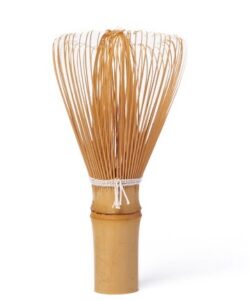
The cha-kin, 茶巾, tea-cloth, is made of bleached asa, 麻, hemp, or nuno, 布, linen or men, 綿, cotton.
Perhaps the ideal chakin is, metaphorically, made of the white hair of Buddha’s byaku-go, 白毫, white-hair, centered above his eyebrows. The cha-sen, 茶筅, tea-whisk, made of take, 竹, bamboo, with white thread, used in very formal and offering Tea presentations. Chasen, L. 3 sun kujira-jaku, circumference – 2 sun kane or 1.6 sun kujira-jaku.
The chakin is closely associated with the chasen, because of the presence of the hemp fiber of the cloth, and the cotton thread wound around the chasen. There is also the similarity of weaving, stitchery, and braiding. White is the color of purity.
In very formal Tea presentations, when examining, turning, and rinsing the chasen in hot water, the chasen is raised three times and rested four times. It is important to remember that the Buddha was a follower of Hindu practice prior to leaving his palace. The Hindu faithful bathe three times daily, in an act of purification. Rinsing three times eliminates the sins of the past, present, and future. It is believed to liberate one from the endless cycle of birth and death, ensuring salvation.
When removing the chasen from the water, the chasen is used to ‘write’ the hiragana, no, の, in the water and the hiragana, no, の, is ‘written’ again in the completion of making a bowl of tea. After the tea has been consumed, the chasen is rinsed in cold water, and raised three times and rested three times, which makes a total of seven times. This may relate to the Buddha’s urna. In Indian philosophy, the location of the Buddha’s byakugo, white hair is at the Ajna, or sixth chakra. It is a spiral that is formed in a clockwise direction in seven coils. A similar feature is present on many Buddhist deities. The character の is written clockwise, which may evoke the urna of Buddha and enlightenment, which is also a clockwise spiral.
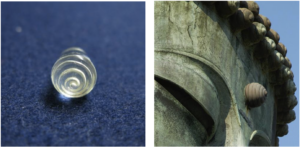
Byaku-go, 白毫, white-hair, carved crystal, clockwise curl. The gemstone often used to create the byakugo is sui-shō, 水晶, water-crystal, rock crystal, high purity quartz. The crystal emulates the clarity and purity of water, and its glistening sparkle. This also connects the chakin to water, which rinses the softens the chakin.
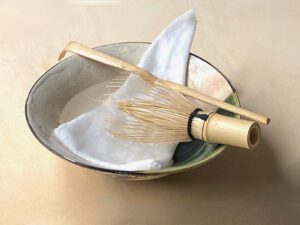
Hira ja-wan, 平茶碗, wide tea-bowl, half-filled with water, with triangular folded cha-kin, 茶巾, tea-cloth, cha-sen, 茶筅, tea-whisk, and cha-shaku, 茶杓, tea-scoop, prepared for the Tea presentation called, ‘Arai ja-kin’, 洗い茶巾, Rough tea-cloth. Arai implies a turbulent surf.
Preparing utensils for the Tea presentation of Arai-ja-kin, 洗い茶巾, Rough-tea-cloth, the chakin is folded into a triangle and placed in a hira-ja-wan, 平茶碗, wide-tea-bowl, that is half-filled with cool water. The chasen and chashaku are set on the bowl that is carried into the Tearoom. In the course of the Tea presentation, the chakin is raised quickly from the water, allowed to drip, and then is folded in half, and wrung dry, twisting it clockwise over the water in the bowl. When the dripping stops, the chakin continues to be wrung until it is dry enough. It is then folded appropriately to wipe the chawan.
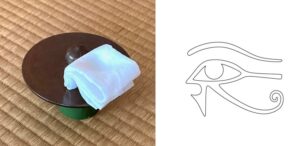
Folded chakin placed on the bronze lid of the kama, 釜, kettle. Note the open and closed aspects of the cloth, providing a hint of negative and positive, In and Yō, 陰 and 陽, Yin and Yang of the Eki-kyō, 易経, Change-sutra. The damp chakin is symbolic of Fire, and the dry metal lid is hot.
When preparing a single bowl of koi-cha, 濃茶, thick-tea, the chakin is used only once. In a similar way, the chasen whisk is first rinsed in hot water, and after whisking the tea, the chasen is rinsed in cold water. Traditionally, the chasen is used only once.
An essential aspect of the Tea presentation of Arai-ja-kin, 洗い茶巾, Rough-tea-cloth, is the sound of dripping water which gives a refreshing feeling in the hot summertime. Wide, shallow bowls are used in hot weather, the broad expanse of water presents a cool feeling. The twisting of the chakin should be turned clockwise with the right hand above, and the chakin corner points, mimi, 耳, ears, should be seen by the guests.
![]()
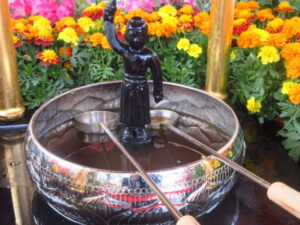
Bronze figure of the newborn Buddha pointing to the sky and earth, standing in a Kan-butsu tarai, 灌仏会盥, Bathe-buddha basin, filled with ama-cha, 甘茶, sweet-tea, with ladles. Note the abundance of marigold flowers, kin-sen-ka, 金盞花, gold-cup-flower, which are flowers Rikyū deemed inappropriate as Cha-bana, 茶花, Tea-flower, as they ‘last forever’. Chabana is for now.
Buddha’s birth, お誕生日, O-tan-jō-bi, お誕生日, Hon.-birth-live-day, is observed on the eighth day of the fourth lunar month, and is formally known as Kan-butsu-e, 灌仏, Bathe-buddha-assembly. However, with the use of the solar calendar, it is usually celebrated on April 8 and called Hana-matsuri, 花祭, Flower-festival. At this time, cherry trees are in bloom, and are often identified with the Hana Matsuri, however, it should be remembered that the flower of Hana Matsuri – Flower Festival, is the lotus, hasu, 蓮, which is sacred to Buddhism. One is reborn on a lotus in the Pure Land of Amida.
In the year 2025, the lunar Kan-butsu-e / Hana Matsuri, occurred on May 5. In Kyōto, lotus flowers bloom from mid-July to mid-August, which is the time of Obon, お盆, and memorial rites.
In some depictions of the birth of the baby Gautama (the Buddha to come) he is being supported by women, as he is bathed by Indra / Tai-shaku-ten, 帝釈天, Emperor-explain-heaven (Deva) and Brahma / Bon-ten, 梵天, Purity-heaven (Deva). After drying the baby with a white cloth, wata, 綿, cotton, the participants set him on an altar bedecked with flowers, burning incense and bottles of perfumed water.
This is a ritual reenacted to this day in the Kan-butsu-e, 灌仏, Bathe-buddha-assembly, ritual. Tiny figures of the newborn Buddha standing in a basin are filled with Kan-ro, 甘露, Sweet-dew, an elixir of life. A special hishaku made of metal or bamboo is used to scoop the ama-cha, 甘茶, sweet tea and pour it over the little figure of the infant Buddha. The common faithful pour one scoop over the figure, whereas Buddhist priests ladle three scoopfuls over the Buddha.

Left: cha-kin tarai, 茶巾盥, tea-cloth basin, bronze; diam. 6 sun kane-jaku. The chakin tarai may be used as a hira ken-sui, 平建水, wide build-water, with the kuwa ko-joku, 桑小卓, mulberry small-stand, for displaying Tea utensils.
Right: Kan-butsu-tarai, 灌仏盤, Libate-Buddha-basin, diameter varies including 6 sun kane-jaku, made for Hana-matsuri, 花まつり, Flower-festival, in which a small figure of the newborn Buddha is bathed in ama-cha, 甘茶, sweet-tea, made with leaves of a special hydrangea. Amacha, sweet tea, may be identified with kan-ro, 甘露, sweet-dew, an elixir of life. Note the pattern of 16 lotus petals, which are Buddhist symbols of rebirth into paradise of Amida. The number 16 is identified with the 16 directions
In the Tea presentation of Shibori ja-kin, 絞り茶器, Wring tea-cloth, the chakin after it is wrung nearly dry, is put into a tall slender, tsutsu ja-wan, 筒茶碗, cylindrical tea-bowl, then the chasen and the chashaku are added to the bowl. It is usually carried into the Tea room. Tsutsu jawan are used in cold weather so that the hands are warmed while clutching the bowl.
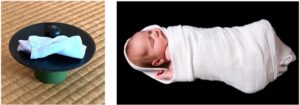
Left: shibori ja-kin, 絞り茶巾, wrung tea-cloth, on a kama no futa, 釜の蓋, kettle’s lid, placed on an ao-dake futa-oki, 青竹蓋置, hearth green-bamboo lid-place. The pictured kettle lid is black-lacquered bronze. Right: baby wrapped in swaddling cloth.
During the Tea presentation shibori ja-kin, the wrung chakin is placed on the kama no futa as is, and then is untwisted and folded in the common manner after hot water is poured into the tsutsu ja-wan. The shibori jakin is a representation of the Buddha’s byakugo. It should be noted that the kettle lid is hot.
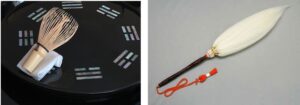
The chakin is always damp, and in the formal Gyō presentation, it is displayed on the large ‘Ha-kke bon’, 八卦盆, Eight-signs tray, of the Eki-kyō, 易経, Change-sutra. The chakin is placed on the trigram ☲, Ri, 離, Fire, together with the chasen, 茶筅, tea-whisk.
The hakke bon trigrams, 三卦, three-sign, shown in the picture above from 12:00 clockwise are: Kan, 坎, Water, Gon, 艮, Mountain, Shin, 震, Thunder, Son, 巽, Wind, Ri, 離, Fire, Kon, 坤, Earth, Da, 兌, Lake, Ken, 乾, Heaven.
The chakin and the chasen are displayed on the hakke bon, on the trigram, ☲, Ri, 離, detach, symbolic of Fire, and the south direction. Also pictured is a Buddhist ho-ssu, 払子, sweep-of, fly whisk mdae of horse tail hair.
The cha-sen, 茶筅, tea-whisk, may represent the ho-ssu, 払子, sweep-of, a fly whisk, which was offered by the King of the Gods, Indra, to the baby Buddha at his birth. The hossu is an emblem of an enlightened Buddhist priest. A hossu is displayed at certain Tea gatherings held by particular Tea traditions.
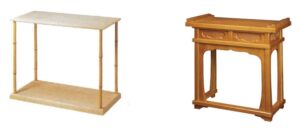
Take dai-su, 竹台子, bamboo support-of, used in a formal Tea presentation which uses a ha-kke bon, 八卦盆, eight-signs tray, placed on the heaven board. The Buddhist kyō zukue, 経机, sutra-desk, is for opening sutra scrolls for study and practice. The raised ends prevent the scroll from rolling off the desk. The tsukue is made in a myriad of forms, designs and adornments.
According to legend, when Shakamuni, the Buddha, was born from the right sleeve of his mother, Maya, a great light of chi-e,智 慧, wisdom-wise, illuminated the ten directions of the world. Seven lotuses appeared, on which, he took seven steps, declaring that he was the only one in heaven and on earth. The Shi-ten-nō, 四天王, Four-heaven-kings, picked him up in wata, 綿, cotton, and placed him on a golden table, kin no tsukue, 金の机, gold/metal ’ s desk. Taishakuten held the lid(?), Bonten held a shiro ho-ssu, 白払子, white (fly)whisk, and both rained down incense. The nine-headed dragon rained fragrant water. The water on the left was warm, and the water on the right was cold: furo/kama on the left, mizusashi on the right.
For further study, see also: April and Uzuki, April in Japan: Following Elephants, Sukigi Gama, and Tea in April

